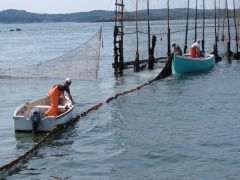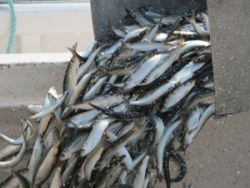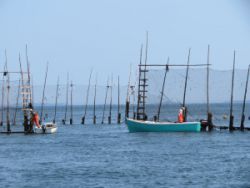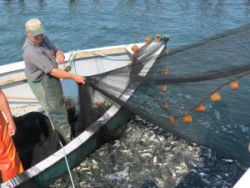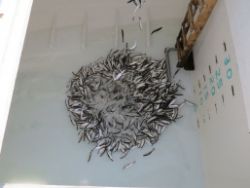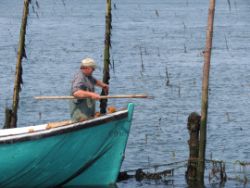Halifax Media Co-op
News from Nova Scotia's Grassroots
Stakes, nets and brush: Building livelihoods in the tide, by Sadie Beaton
This blog was originally posted at Small Scales, the excellent East Coast fisheries blog administered by the Marine Issues Committee of the Ecology Action Centre. Follow the always interesting Marine Issues Committee on Twitter.
An interview with Lois and Dale Mitchell, by Sadie Beaton.
My two-year old and I eat sardines for lunch at least once a week, usually with mustard and crackers, or in a sandwich with some avocado, olive oil and lemon zest.
Canned sardines are cheap, easy to prepare and loaded with nutrition, including Omega-3 fatty acids and calcium. Abundant, and low on the food chain, these small herring are also a relatively sustainable seafood choice. (‘Sardines’ caught in Atlantic Canada are actually small herring, not to be confused with Sardinia, found in the Mediterranean and western Europe.) But, like pickled herring, sardines are still awaiting their time in the local food limelight.
Many Atlantic Canadians don’t realize that sardines are caught and canned locally. Fewer still know that many of our local sardines are caught by one of the most ancient, fascinating and sustainable fishing gears- the herring weir. The herring weir is a clever trap that takes advantage of the tides and natural schooling behaviour of herring. They are also beautiful- when seen from above, they are works of art.
Dale Mitchell’s family has been weir fishing since the 1820s. These days, he fishes with his son and son-in-law, and hopes his grandchildren will be able to enter the fishery when they are old enough. That’s part of the reason that Dale is so involved in fishing organizations, including Fundy North Fisherman’s Association (FNFA) the Traditional Fisheries Coalition (TFC), and on the board of directors of Fundy Weir Fishermen’s Association (FWFA).
Dale and Lois Mitchell were generous enough to take some time with me in the middle of their busy weir fishing season, so I could ask them a bit about how the weir fishery works, and what changes they have seen over the last few decades.
Weirs are such a unique fishing method, involving traps built from stakes, nets and brush. Can you describe how the fishery works?
“Weirs are like a corral that are strategically placed to catch herring as they naturally move according to the tide and the moon. They usually cover about an acre and are often heart-shaped. Once the fish are in the weir they tend to swim in circles and the heart shape prevents them from going out through the mouth of the weir.
Fish are more likely to come ashore if there are predators chasing them, but they also come to our area because of the high productivity of the water – that is, there is a very high plankton content around the Deer Island archipelago. Their principle predators include mackerel, squid, dogfish and groundfish.
Most weirs catch fish in the night. The best tides are moonless nights (or dark nights where fog or clouds cover the moon) and when flood tide is in the dark and ebb tide is at daylight. Once fish have been caught they are “seined up” inside the weir at low tide and then pumped aboard a herring freighter to be transported to the plant in Black’s Harbour.“
How has the fishery changed over time?
“The weir fishery combines both ancient and modern technologies. The basic operation has remained the same since the weir fishery was first used by First Nations people. However, twine has replaced brush (first it was cotton twine that had to be tarred each year to prevent it from rotting; in the mid sixties, synthetic twine replaced cotton twine). Weirs can now be built in deeper water because the twine is stronger.
Scuba diving has also had an impact since divers tie the bottom twine down every year to keep the weir tight – the twine is tied to the base of the stakes.
Tending the weir has also been made easier by the use of fathometers. Previously fishermen estimated how many fish were in the weir by using a piece of #2 linen thread with a one-pound weight on the bottom. Skilled fishermen could judge the quantity of herring by ‘feeling’ the ticks on the thread as the fish passed by.
Fathometers were introduced in the early 1970s – they ‘mark’ herring on a video screen in different colours according to the density of the fish under the transducer.”
The Connors Brothers sardine cannery is the main buyer for weir sardines in your area. How does this relationship work and how has it changed over time? Do they pay a premium for weir-caught herring?
“Originally Connors was owned by Lewis and Patrick Connors of Black’s Harbour and then the MacLeans of Black’s Harbour. These people lived in the community and understood the industry. Blacks Harbour was a company town. With ownership moving away (which was probably a necessary thing due to capitalization), the local operators are under constant pressure to make a consistent, year-round profit. This has made them more dependent on the purse seine fleet and a more industrial model of fishing.
While Connors Bros. is now answerable to a large private investment company, we feel the local managers are very competent and are working with us to sustain this fishery for the benefit of all of us. We work together in a Traditional Fishermen’s Coalition and amongst other topics, we talk about ways to promote traditional fisheries (weirs, shut-off fishing, inshore lobster and scallop fishing).
The advantage of weir (or shut-off) caught fish is that they make a better quality product because they stay firmer in the can (because they don’t have feed in their stomachs). Fish caught in weirs and shut-offs do get a better price than purse-seine fish.”
How has the weir fishery changed over the last thirty years or so?
“The biggest change for us is in terms of the relative value of the various fisheries to our overall income. Thirty years ago the weir fishery was what kept families going. It was a boom and bust fishery but when it was booming there was a lot of money to be made in the weirs. Lobster and scallop fishing were small “bread and butter” fisheries back then – that is, they kept you going from one weir season to the next and there was always the hope that each weir season would be a “good one”. The whole economy in communities like Deer Island reflected the boom and bust nature of the weir fishery.
When the weirs were fishing everything thrived. Now, lobster fishing is the backbone of our community and quite a few people have gotten out of the weir fishery altogether. There are now 14 built weirs around Deer Island and only about half of them have been seined this year at all. That’s down from 69 in 1985 and 100 or more in the 40s and 50s. For the first time we’re really starting to wonder if the weir fishery will be able to survive.”
Why do you continue to fish using a weir?
“Fishing (for Dale and so many other traditional fishermen) is a way of life. That’s significant because in this day and age when people are so focused on getting a “job”, they have a whole different mindset. Pretty much everything Dale does stems from his commitment to a way of life and preserving that way of life in an economic and political environment that talks about sustainability but doesn’t really believe that it’s possible. And, from my perspective, it isn’t so long as we can’t let go of the growth models and assumptions of the last century or more.
At least until recently, fishermen realized that debt is a trap and potentially the undoing of the way of life they’ve inherited and want to pass on. For instance, a lobster fisherman who has a mortgage on his house, a boat payment, car payment and credit card debt simply cannot “make money” when the price of lobster falls below a certain amount (say $5/lb). A fisherman who has no debt, however, can weather price drops and other vagaries of nature, politics and economics.”
Lois and Dale Mitchell live in Deer Island, New Brunswick.
The site for the Halifax local of The Media Co-op has been archived and will no longer be updated. Please visit the main Media Co-op website to learn more about the organization.
